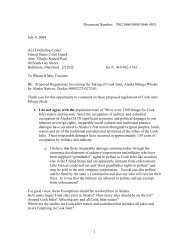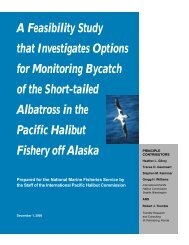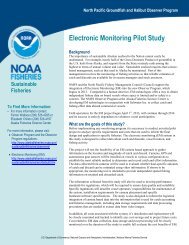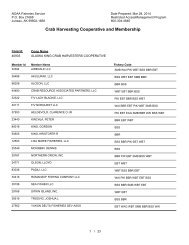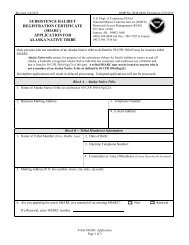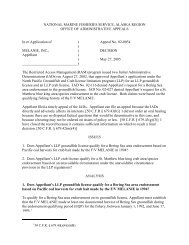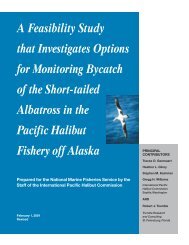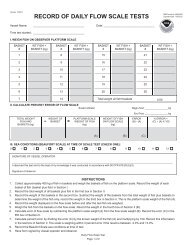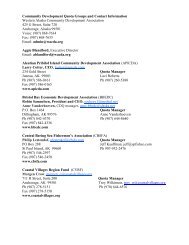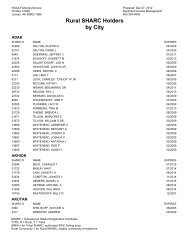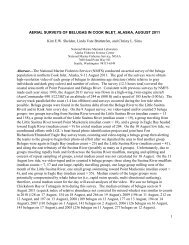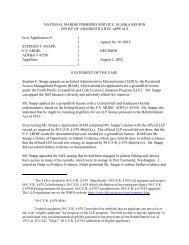Petition to List Lynn Canal Pacific Herring under the Endangered ...
Petition to List Lynn Canal Pacific Herring under the Endangered ...
Petition to List Lynn Canal Pacific Herring under the Endangered ...
You also want an ePaper? Increase the reach of your titles
YUMPU automatically turns print PDFs into web optimized ePapers that Google loves.
definable area (Booke, 1981); and (4) an intraspecific group of randomly mating<br />
individuals with temporal or spatial integrity (Ihssen et al., 1981).<br />
None of <strong>the</strong>se definitions imply that a fish s<strong>to</strong>ck is ecologically, biologically, or<br />
physiologically significant in relation <strong>to</strong> <strong>the</strong> biological species as a whole. Hence,<br />
information establishing a group of fish as a s<strong>to</strong>ck, such as <strong>the</strong> Cherry Point s<strong>to</strong>ck<br />
of <strong>Pacific</strong> herring, does not necessarily qualify it as a DPS. A DPS may be<br />
composed of a group of related s<strong>to</strong>cks, or in some cases (if <strong>the</strong> evidence warrants)<br />
a single s<strong>to</strong>ck, that form(s) a discrete population and are (is) significant <strong>to</strong> <strong>the</strong><br />
biological species as a whole.<br />
(NMFS 2005c)(emphasis added). However, in this instance, NMFS has strayed from <strong>the</strong><br />
specific language of <strong>the</strong> DPS Policy. Instead, NMFS required that <strong>the</strong> Cherry Point<br />
<strong>Herring</strong> not only be “significant <strong>to</strong> <strong>the</strong> taxon” as stated in <strong>the</strong> DPS Policy, but also that<br />
<strong>the</strong> population be “ecologically, biologically, or physiologically significant.”<br />
NMFS also dismissed <strong>the</strong> importance of local herring populations <strong>to</strong> <strong>the</strong> species<br />
as a whole when it discussed metapopulations in <strong>the</strong> Cherry Point <strong>Herring</strong> final rule.<br />
A “metapopulation” is an aggregation of subpopulations linked by migration, and<br />
subject <strong>to</strong> periodic extinction and recolonization events (Levins, 1968, 1970).<br />
Observations of herring population structure in <strong>the</strong> Atlantic and <strong>Pacific</strong> are<br />
consistent with this metapopulation concept (McQuinn, 1997; Ware et al., 2000;<br />
Ware and Schweigert, 2001 ,2002; Ware and Tovey, 2004): (1) local herring<br />
s<strong>to</strong>cks are distributed across spatially fragmented spawning habitat; (2) local<br />
s<strong>to</strong>cks exhibit partially independent demographics and dynamics; (3) <strong>the</strong>re is<br />
appreciable straying and gene flow among local populations; and (4) <strong>the</strong>re is<br />
evidence of disappearance and recolonization events.<br />
Consistent with <strong>the</strong> consideration of <strong>Pacific</strong> herring as a metapopulation, local<br />
spawning s<strong>to</strong>cks of herring may demonstrate distinctive demographic patterns and<br />
reproductive isolation over relatively short temporal scales, yet over longer time<br />
periods regularly exchange low levels of individuals or experience periodic waves<br />
of dispersal during years of abundant recruitment.<br />
(NMFS 2005c)(emphasis added). NMFS uses <strong>the</strong> metapopulation model in this instance<br />
<strong>to</strong> thwart species protection. Subsequent research in herring metapopulations not yet<br />
reviewed by NMFS is presented below. This new information shows that herring<br />
population structure is more complex than originally estimated. In <strong>the</strong> last decade, many<br />
herring populations that were once thought <strong>to</strong> be a single population have been divided<br />
in<strong>to</strong> genetically distinct subpopulations.<br />
NMFS reliance on McQuinn (1997) in <strong>the</strong> 2001 and 2005 status reviews for<br />
Cherry Point herring is misleading. NMFS used <strong>the</strong> metapopulation model <strong>to</strong> essentially<br />
preclude significance at <strong>the</strong> local population level by assuming that recolonization events<br />
would always res<strong>to</strong>re some herring population.<br />
33



